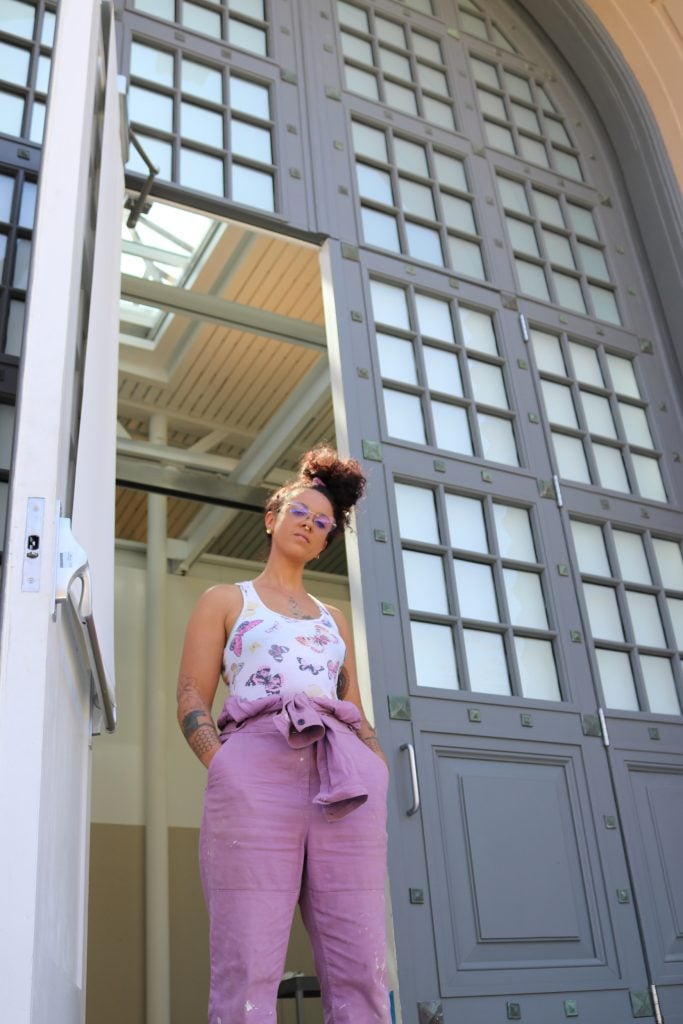Interdisciplinary artist Amaryllis DeJesus Moleski thinks of her studio as a portal, one that connects the artworks she makes with her lived experience. Right now, the artist—and her studio—are in a “serendipitous” moment of flux. After years of living and working in New York City, DeJesus Moleski recently made the move to leafy upstate New York, where she has built a new studio.
At the moment, however, the artist is working in a third studio: a 900-square-foot visual arts studio at the new David Rockefeller Creative Arts Center (DR Center) where she’s completing a two-month residency. DeJesus Moleski, who grew up moving to cities across the U.S., thrives in such in-between spaces and moments. This studio, she points out, comes with its own history—it’s situated in an orangerie built by John D. Rockefeller at Pocantico, the family’s historic home, in Tarrytown, New York.
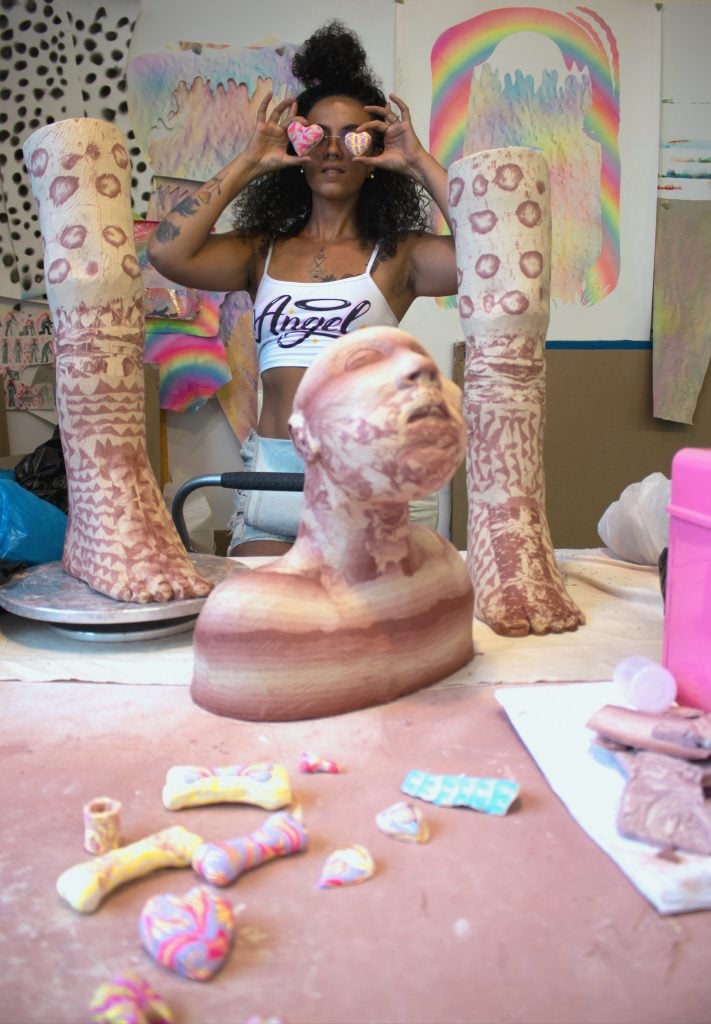
Amaryllis Dejesus Moleski inside DR Center studio, 2023. Courtesy of the artist.
The DR Center opened this past fall after extensive transformations by architects FXCollaborative with a mission of supporting artists across performing, literary, and visual arts. DeJesus Moleski, who was named the recipient of the 2023 Pocantico Prize for Visual Artists, is the second artist in residence
DeJesus Moleski says the studio and lush, nature-filled grounds, are “giving Sound of Music” and here she’ll spend the next weeks creating across media—paper and clay are her current obsessions—as she prepares for a solo exhibition at the Union for Contemporary Art in Omaha scheduled for this fall. DeJesus Moleski, who is queer and Puerto Rican American, imbues her works with femme cosmologies and symbologies, offering alternative symbolic narratives to those rooted in colonialist histories, and marks these visions with luminous color.
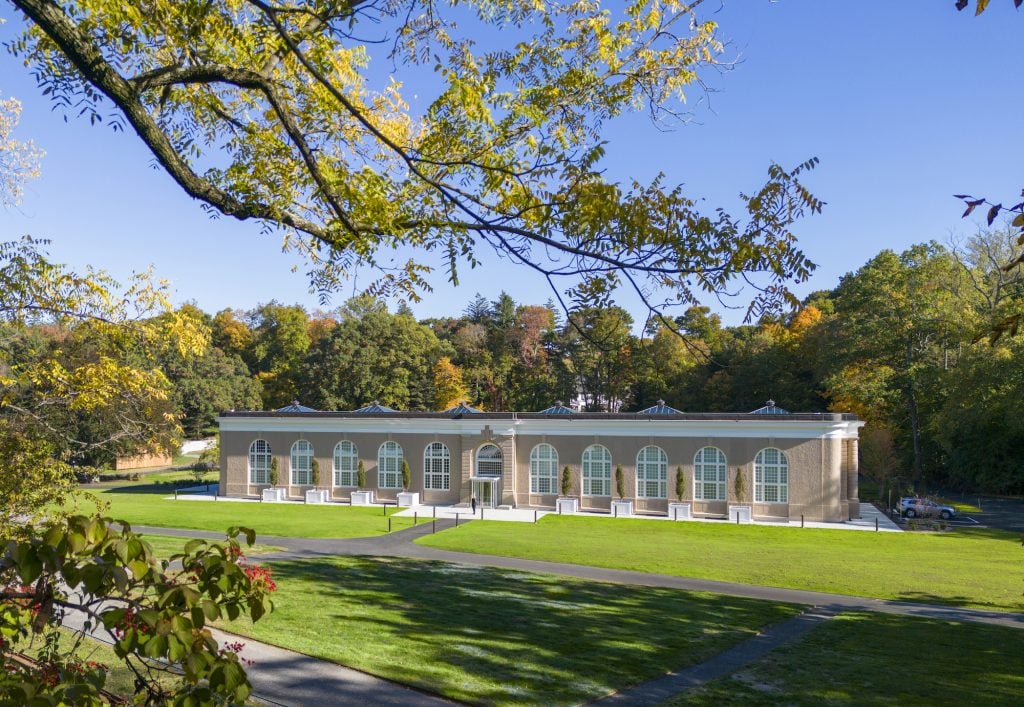
Pocantico/Rockefeller Creative Arts Center in Tarrytown, New York. Architect: FX Collaborative Architects
Recently we caught up with the artist, who told us about the Japanese clay technique she can’t get enough of, the wildlife encounters she’s anticipating, and how Buffy the Vampire Slayer is keeping her motivated 20 years on.
Tell us about your studio. Where is it, how did you find it, what kind of space is it, etc.?
It’s serendipitous, actually, as I’ve just begun an artist residency at the Pocantico Center in Tarrytown, which dovetails nicely with a major studio transition. About six months ago my partner and I made the move from the city to the mountains of upstate New York. We went from living on the sixth floor of a very special apartment building to six acres of oak forest and open air where wildflowers grow in the summer. Living rurally has given me the opportunity to completely reshape the space that I am working in, and spread out in a way that I couldn’t before. My recent studio was in Long Island City and I worked on top of a brightly colored taxi business sharing space with a small group of other amazing artists. I was so lucky to get into this studio space run by artists who were committed to keeping rent prices low. That’s why I originally chose the studio, but over time I got to know the neighborhood and treasured how incredibly fortunate I was to make work in the area. I studied clay with Rosanne Ebner at Brickhouse Ceramic Arts, just a seven-minute walk from my studio. I started making large-scale ceramics and solidified my love of the Nerikomi clay technique, and Sculpture Space NYC was just down the block, providing access to massive kilns. My studio walls were covered in three years of paint, clay, airbrushed rainbow edges, glitter, mirrors, sequins, footprints, piles, and smudges.
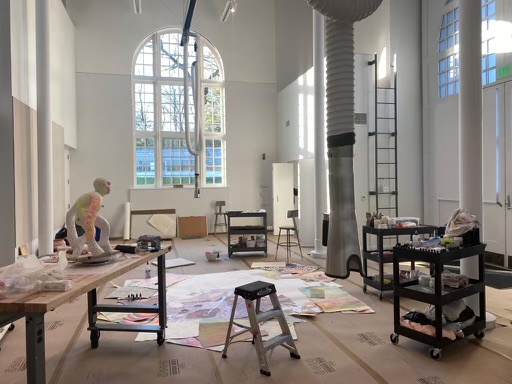
Inside Amaryllis DeJesus Moleski’s residency studio at the David Rockefeller Creative Arts Center. Courtesy of the artist.
Tell us about your soon-to-be upstate studio and your residency at Pocantico.
The new studio began construction in December 2022, and I simultaneously received the Joan Mitchell Fellowship, which supported its completion early this year. This studio is bright gumball red on the outside and has floors the color of strawberry ice cream on the inside. There are turkeys and deer that graze in the clearing out front. I think this summer I may meet the bears that are waking up from hibernation. When the sky is clear I can see more stars than I ever have in my life—it’s giving Rihanna. There is space for me to dig into the earth, and later this summer I will pit-fire the clay figures I am currently building onsite here at Pocantico in a two-month residency, with use of the new David Rockefeller Creative Arts Center studio. I just moved into the gorgeous 1000-square-foot space last week to live and work on the property: 216 acres of gardens, sculptures, artwork, hills, and surrounded by the creative people who have made this all possible. Right now there are pink and white magnolia trees in full bloom, Lin Emery making the light dance outside my door, crab apples, fox visitors, and sweeping cherry blossom willows. It’s giving Sound of Music. The history here is felt. Each of these three studio experiences are very special portal places to me, connecting art with life over the past few years.
Do you have studio assistants or other team members working with you? What do they do?
I’m really fortunate to have longtime artist friends in my sphere, and more recently I’ve been able to bring two dear friends onto my studio team in a more formal capacity.
Ginger Dunnill produces large-scale projects globally and is an incredible sound artist. She also runs Slay Arts Management, providing creative admin support for artists, and has been my Studio Director since 2021. Ginger is like the weaver in my studio; she connects all the different threads of communication and makes sure the fabric of my practice is strong. She has also been handling my social media and website, affording me so much more space for creative experimentation, mental freedom, and overall wellness. During my current residency at Pocantico, I was able to bring on another longtime friend and amazing musician and multidisciplinary artist India Sky. We have been supporting each other’s work over the course of our 15-year friendship, so it feels really special to have her assistance in the studio at this time.
Ginger, India, and I have built a community together through art-making back in Santa Fe, New Mexico, long before we developed careers in the art world. We created strange just-for-the-hell-of-it performances and underground cabarets and made lots of weird art that existed in backyards and parking lots. Because our shared history as artists came long before the professional side of things, the trust is already there.
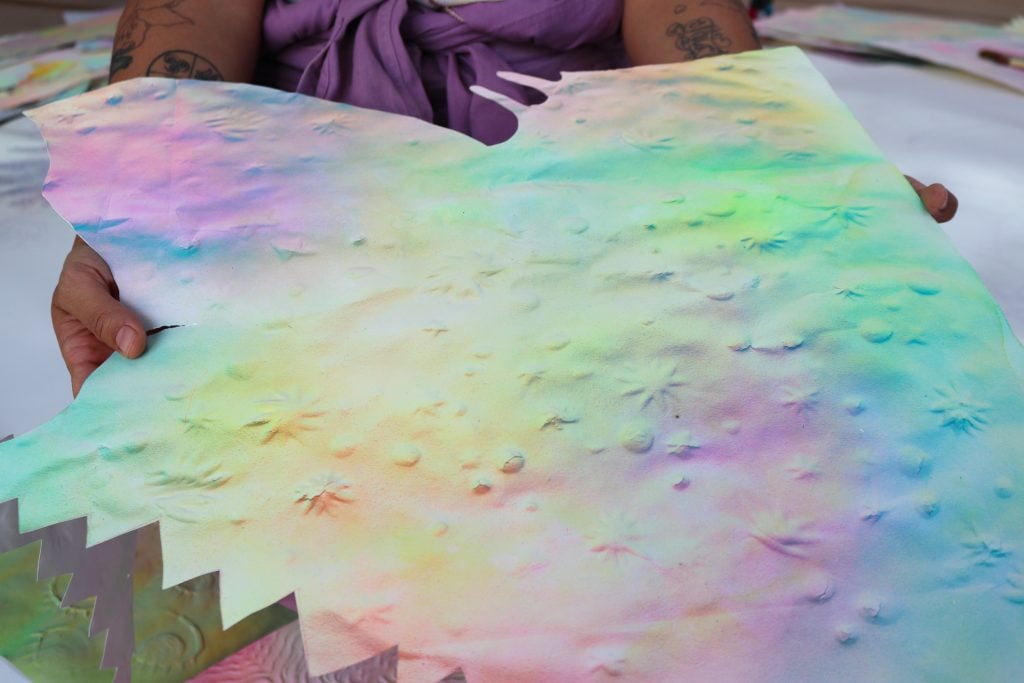
The artist will airbrush and watercolor paper embossments. Courtesy of the artist.
What is the first thing you do when you walk into your studio (after turning on the lights)?
I put on my headphones and select what I’m gonna listen to—music is essential! The best studio purchase I ever made was a nice comfortable pair of headphones. Game changer.
What is a studio task on your agenda this week that you are most looking forward to?
I have a bunch of carved paper embossments that I made during my 2021 Key-Holder Residency at the Lower East Side Printshop. While I had access to their printing press, I made as many patterns and textures as I could to play with in the studio later. I brought them all here to the David Rockefeller Creative Arts Center studio, and next up is to paint them with watercolors and airbrush—two of my favorite paper mediums. I love this part of the process because the paint is just tracing what is already there—making the embossments into psychedelic topographical map-like patterns.
I love paper because it’s alive. It has a memory of everything it touches, and if those touches are erased it keeps the memory of that erasure too. It bends and buckles, absorbs, and dissolves; constantly adjusting in order to account for its own history. It’s made of so many non-paper elements that exist before we ever touch it: sun, rain, soil, tree, cloud, hoof, hide, and other chemical transformations. Right now, I am experimenting with how to embed color and drawings into the paper. Through all of these experiments, I’m building a material library for collages and sculpture. Each piece becomes a future part of a larger work. Much like Nerikomi clay work, what you see isn’t a surface treatment on top of the substrate, it’s embedded into the fiber of the thing. It’s structural and inseparable from what holds it.
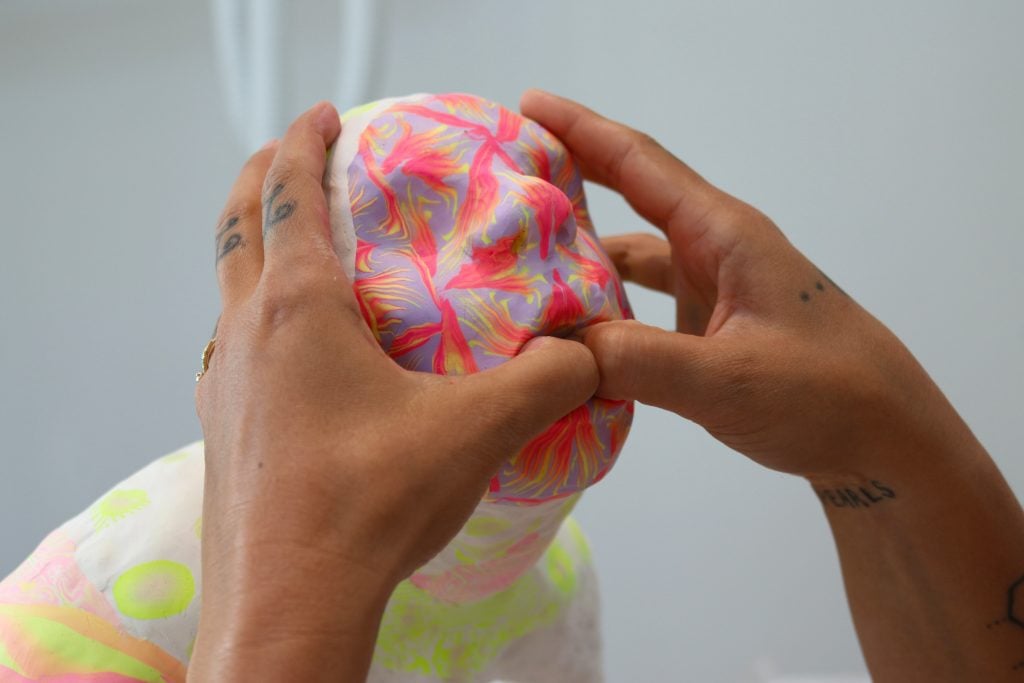
A work-in-progress made with the Nerikomi technique. Courtesy of the artist.
What are you working on right now? Please send us a few smartphone shots of a work in progress—or photos of different works in various states of completion—in a way that you think will provide insight into your process.
Clay has my heart at the moment, and I’m working on some larger ceramic Nerikomi figures, and continuing my drawing practices by carving into the clay bodies as well. Nerikomi is a ceramic technique that has roots in antiquity but gained recognition through contemporary Japanese pottery. It is the process of cutting and re-attaching different clay bodies together to create a pattern through meticulous destruction and reformation that is not a surface treatment, but structural to the piece itself. So no matter how much you carve, wash, or scrape away at the surface the pattern exists through the whole body. It’s like a creation destruction loop where you’re literally building something through a process of falling apart. To make these figures I cut apart different bodies of clay, slicing and scraping them into many pieces, then reassembling them into whole patterns. Even when I think I know what patterns I’m making they always warp and shift and reveal themselves to be different than my intentions. Like paper, clay has its own memory and mystery, and timeline that I cannot control, only co-create with. The fragments become the patterns that become the building block that becomes the irreverent, mutable, weird bodies that change irreversibly with time.
What kind of atmosphere do you prefer when you work? Is there anything you like to listen to/watch/read/look at etc. while in the studio for inspiration or as ambient culture?
Audio is essential! I need heavy bass in my ears, or loud enough to fill the studio. On the best days, the music gives my radically unhelpful ruminating mind something to focus on so that I can zone out and tune in. I have playlists for different moods and times of day. And when I start to feel isolated, I’ll switch it up and listen to podcasts and audiobooks. Ginger Dunnill created and produces a podcast called Broken Boxes, which shares intimate long-form conversations between artists about life and work. Listening to these conversations helps me to feel more connected and less alone. When I’m pulling super long hours on a deadline, I’ll put on Buffy the Vampire Slayer in the background, a show I’ve been watching on repeat since it ended in 2003. Yeah, I said that: 20 years of Buffy and it still keeps me going when I want to quit.

Courtesy of the artist.
When you feel stuck while preparing for a show, what do you do to get unstuck?
The hardest thing for me to do is walk away from the work when I’m under time pressure, but it’s almost always the only thing that gets me unstuck. When I’m stuck and everything I do feels like I’m fighting against the current, it’s usually because I’m trying to be a machine and not a person. It usually means that I need to get back into my body, eat a sandwich, hug my partner, hug my cats, do the dishes, take a shower, go to sleep. Come back refreshed.
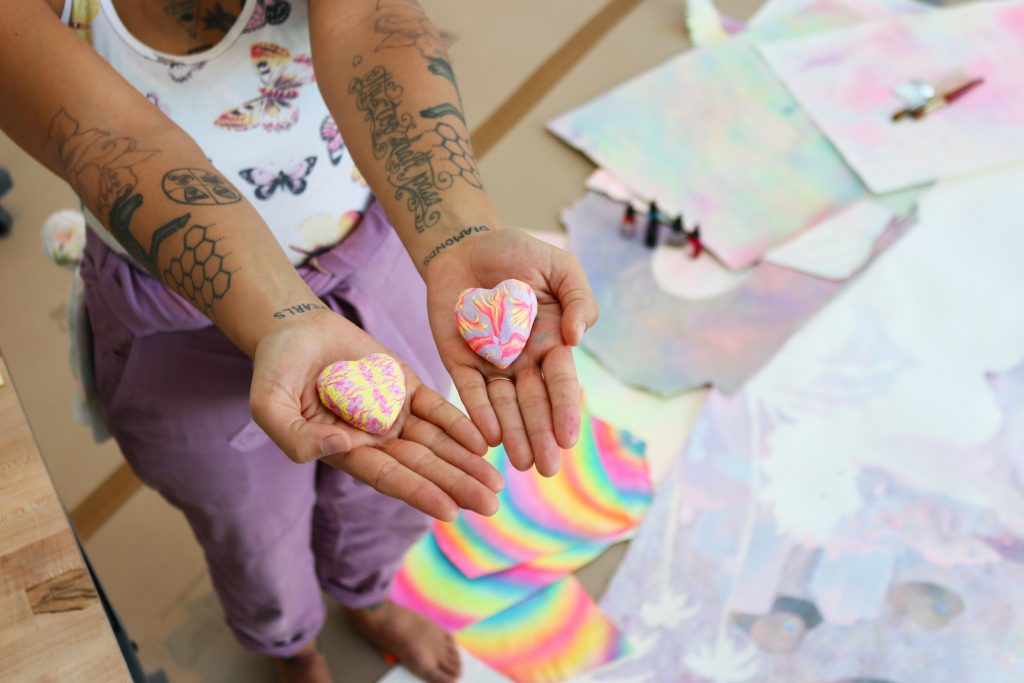
Heart eyes and hands. Courtesy of the artist.
What’s the last museum exhibition or gallery show you saw that really affected you and why?
A while back I had a site visit with the amazing folks at the John Michael Kohler Arts Center in Sheboygan, Wisconsin, that left such an impression on me. It comes to mind regularly in my practice and stands out as one of my favorite art institutions that I’ve visited to date. The Art Center has dedicated its space to collecting artist-built environments—quite literally lifelong works of art built intricately into the homes and spaces they inhabited. It’s some of the most amazing installation art I’ve seen. One installation that particularly stood out to me was the re-created home of Loy Bowlin from a rural county in Mississippi, also known as “The Rhinestone Cowboy.” Every inch of the interior and exterior of his home was covered in intricate collaged patterns made from construction paper, Elmer’s glue, and glitter. The curator taking us through the preserve shared the anecdote that Loy Bowlin’s “Beautiful Holy Jewel Home” was a project born of his loneliness and isolation. He wanted to make his home into something so bright and sparkling that it would draw people to it. The materials he used to create this life-long project really spoke to me as an artist and craftsperson. Paper, glitter, glue—these everyday craft materials were my entry point into art making as well. These materials hold just as much worldly significance and historical lineage as marble, oil paint, or bronze. I love the JMKAC Art Preserve because installation after installation is honoring the lives and environments of artists who made work not for a show or exhibition, but because they had to. I resonate with that.
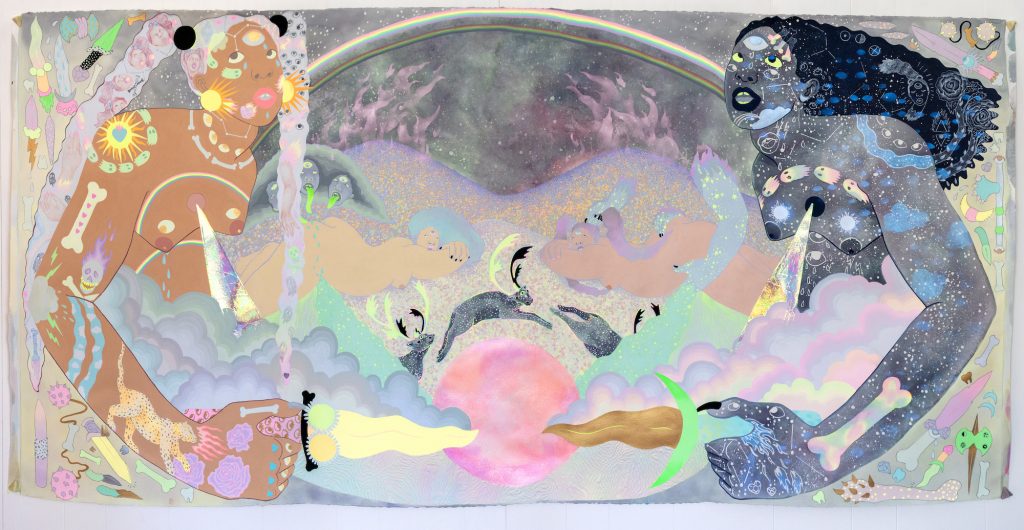
Amaryllis DeJesus Moleski, Against All Origins (2023). Courtesy of the artist.
Is there anything in your studio that a visitor might find surprising?
I have a large collection of the now discontinued Homies figurines created by cartoonist David Gonzales. They were amazing because for a time you could get them for 50 cents out of gumball machines in supermarkets and restaurants. I used to be obsessed with collecting them everywhere I went. I taught art and poetry classes at a Middle School in New Mexico for a time and across the street was a favorite burrito spot of mine, so on my breaks, I would run across, get a Homie and a burrito and run back. I used to carry them everywhere with me and travel with them as good-luck charms, and now they live in my studio, tucked in-between other random treasures.
Describe your studio space in three adjectives.
Flamboyant. Alchemical. Alive.
